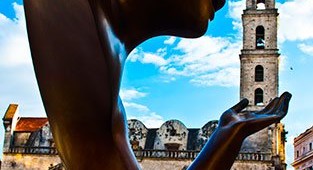
La Conversación Statue LH  4
4
The beautiful contemporary bronze sculpture titled ‘La Conversación’ looks out over Plaza San Francisco de Asís from atop a marble plinth in front of the entrance to the Lonja del Comercio. Made by Fr …

Cinemateca de Cuba (Cine Chaplin) LH  4
4
The Instituto Cubano del Arte e Industria Cinematográficos (ICAIC) was the first cultural institution created by the Revolutionary Government on March 24, 1959. Its objective was to organize, establis …

La Moderna Poesía LH  4
4
Owned by the López Serrano family–who evidently had a preference for Art Deco–this bookstore is a sample of how the sober interplay between lines and volumes can achieve a discreet elegance highligh …
 Art DecoAdmission: FreeObispo y Bernaza, Habana Vieja
Art DecoAdmission: FreeObispo y Bernaza, Habana Vieja 
Teatro Martí LH  4
4
Elegant and simple, this Romanesque-style theater opened in 1884 as Teatro Irijoa and changed its name to Teatro Martí in 1900. Because of its location in Habana Vieja and its great acoustics, it achi …

Hostal Conde de Villanueva LH  4
4
The former 18th-century mansion of Claudio Martínez de Pinillos, Count of Villanueva, leader of Cuban Creole society in the 19th century, was restored in the 1990s to create a charming and comfortable …
 ColonialAdmission: n-aMercaderes #202, e/ Lamparilla y Amargura, Habana Vieja
ColonialAdmission: n-aMercaderes #202, e/ Lamparilla y Amargura, Habana Vieja 
Agromercado de 19 y B LH  4
4
With fresh organic products that include fruits, vegetables and meat, this agromercado is best known among locals for being one of the best stocked open-air vegetable markets in the city.

Palacio de los Matrimonios (Casino Español) LH  4
4
Built in 1914 as Casino Español, one of the several Spanish social clubs in Havana, this beautiful Neo-Renaissance building boasts a ballroom that takes up the entire upper floor and that in itself is …
 RenaissanceAdmission: NonePaseo de Martí (Prado) 306 esquina a Ánimas
RenaissanceAdmission: NonePaseo de Martí (Prado) 306 esquina a Ánimas 
Habana 1791: The Perfume shop LH  3
3
Habana 1791: The perfume shop Located in an 18th-century mansion at the corner of Mercaderes and Obrapía, this beautiful shop and laboratory sells 12 varieties of scents or colognes. The bottles are m …

Edificio del Retiro Odontológico LH  3
3
In 1953, architect Antonio Quintana won the competition for the design of a building which would house doctors’ offices, stores and other public spaces. The use of brise-soleil, popularized by the Fre …
 ModernL entre 23 y 21
ModernL entre 23 y 21 
Casa de Dionisio Velasco LH  3
3
Built in 1912, the building was conceived as a grand palace. Lavishly ornamented on its facade, it features overhanging balconies and windows which break the horizontal line of the balustrade. This mo …
 EclecticAdmission: FreeCárcel #51 esq. a Zulueta, Habana Vieja
EclecticAdmission: FreeCárcel #51 esq. a Zulueta, Habana Vieja 


